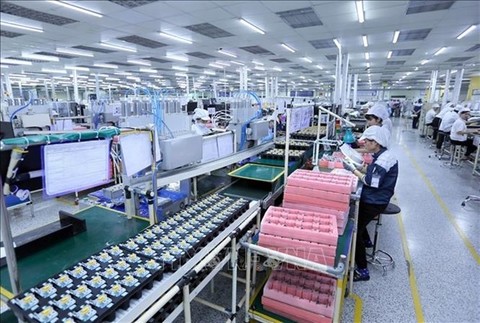
An electronic circuit board production line at Nexcon Việt Nam Co., Ltd., a Korean-invested company in Bắc Ninh. — VNA/VNS Photo
Although there are many opportunities to participate in the global value chain through supplying products and components to large foreign corporations investing in Việt Nam, the reality is that too few Vietnamese companies have taken advantage of this opportunity.
Many point out that the 'bottleneck' is because the majority of supporting industries are small-scale, have financial difficulties, lack high-quality human resources and have not focused on investing in technological chains.
Although growing in scale and quantity and some Vietnamese supporting industrial products are being exported to a number of countries around the world, but the productivity of domestic enterprises is still low, not meeting the requirements of large corporations in Việt Nam in terms of quantity, design as well as quality and delivery time.
Experts said that Việt Nam had become one of the attractive investment destinations for many global corporations and enterprises.
However, the number of Vietnamese enterprises participating in the global supply chain was still limited and required effective solutions to improve their ability to participate in the global supply chain.
Economic expert Trần Đình Thiên pointed out that Việt Nam's economy was highly open and increasingly integrated, but domestic companies were still largely unable to participate more deeply in the global supply chain.
The reason was that the level of industry was still low. Việt Nam was still basically a processing production system, with weak automation and digitalisation integration and the industrial chain system was not clear, he said.
Furthermore, Vietnamese industrial enterprises and businessmen had not really created industrial links between their domestic market and the world and they had not led the industrial chain of enterprises, corporations and the world into Việt Nam.
In addition, the capacity of domestic enterprises, especially in the technology sector, was a major obstacle to attracting the supply chain of technology corporations into Việt Nam, as well as limiting the country's ability to participate in the upstream stage in the global production network.
If these weaknesses are not promptly overcome, companies risk falling deeper into the trap of processing and assembling, making it difficult to control low-quality investment flows, investment in acquiring domestic markets and enterprises and investment in disguise, experts have pointed out.
As an item that accounts for an increasingly large proportion of total export turnover, the growth of electronics, computers and components has a significant impact on the overall growth of the country's exports.
Although the electronics industry earns hundreds of billions of US dollars in exports each year, the economic benefits of participating in the global electronics supply chain are relatively small, because the domestic process is limited to a very narrow range of functions, mainly just assembly and processing.
Deputy director of the Việt Nam Industry Agency Phạm Tuấn Anh said that electronic products often had a relatively short lifespan, frequently changing features and designs, while the capacity of domestic enterprises was limited so there were not enough resources to invest in research and development of products and brands.
Therefore, the stage with highest added value still depended on foreign production chains, he said.
In addition, the tightening regulations on sustainable production in Europe and the US had created more pressure and risen costs for Vietnamese enterprises, which are modest in scale and resources.
To overcome the problems, in addition to focusing on improving the quality of human resources, domestic enterprises needed to pay more attention to invest in production lines, apply science and technology, to better meet the requirements of quantity, quality and delivery time, said Anh.
At the same time, they also needed to strengthen links with domestic and foreign research institutes and foreign corporations to learn and access new technology lines more quickly, he added.
By doing so they would be able to improve production capacity, meeting the requirements of foreign corporations and participating more deeply in the global value chain, he said.
Giving advice to companies, Tạ Hoàng Linh, director of the European - American Market Department under the Ministry of Industry and Trade, emphasised that enterprises needed to proactively grasp information, position themselves strategically in the market and target customers.
They should focus on researching and developing products suitable for each sector, building a systematic production and export plan to be able to adapt to the requirements of distributors when participating in the supply chain, he added.
At the same time, businesses needed to make efforts to green production, ensure transparency in traceability throughout the entire value chain and focus on building and promoting brands, said Linh.
Going forward, the Ministry of Industry and Trade would continue to promote market information, communication and training to support raising business awareness of sustainable development, green production and brand building.
In particular, the ministry would, through cooperation mechanisms, continue to advocate policies with trade partners to remove barriers to market access and minimise the cost burden for manufacturers and exporters.
In addition, the ministry would continue to work with ministries, branches and associations to promote trade as well as support businesses to consume goods in the domestic and export markets. — VNS